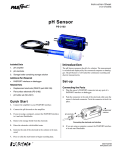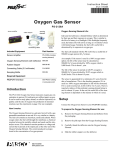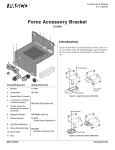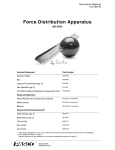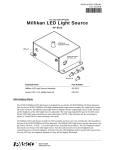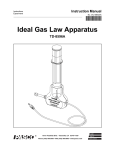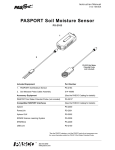Download PASCO Specialty & Mfg. PS-2194 User's Manual
Transcript
I n s tr u c t i o n S he e t 0 1 2 - 1 0 2 8 7B Ethanol Sensor PS-2194 Introduction 1 2 The Ethanol Sensor measures the concentration of ethanol in a gas or indirectly in a liquid. The sensor’s probe contains a material whose resistance decreases in the presence of ethanol. The sensor translates this resistance into an ethanol concentration measurement, which is recorded and displayed by the connected computer or datalogger. The Ethanol Sensor is well-suited for continuous recording and discrete measurements. Precautions • Do not expose the probe to gas containing more than 3% ethanol, including the gas above alcoholic beverages. Higher ethanol concentrations will deplete the sensing element. Note that the gas above a liquid contains about the same concentration of ethanol as the liquid itself. • Ensure that the membrane is installed and intact before using the probe. The membrane prevents the sensing element from getting wet. If the sensing element accidentally gets wet, rinse and dry it quickly. Note that the probe may be degraded or destroyed. • Do not immerse the probe. The membrane (if it is in good condition) will protect the probe in case of accidental immersion. However, the probe is designed for use in gas only. Included Parts 1. Amplifier 2. Probe 3. PTFE tape for membrane replacement (not pictured) Additional Part Required • PASPORT interface or datalogger Related Parts • Replacement probe (PASCO part 003-10338) • Additional PTFE tape (720-062) Quick Start 1. Connect the amplifier to your PASPORT interface. 2. Connect the probe to the amplifier. 3. If you are using a computer, connect the PASPORT interface to it and start DataStudio. 4. Ensure that the membrane is installed and intact. There should be no tears or discoloration. 5. Place the end of the probe in the gas above a solution containing less than 3% ethanol. Connecting the Parts 1. Plug the amplifier’s PASPORT connector into any port of a PASPORT interface or datalogger. 2. Connect the probe to the amplifier. probe 6. Press or click the start button to begin recording data. The probe stabilizes after about 10 minutes of warm up time. ® to PASPORT interface Connecting the probe and interface 3. If you are using a computer, connect the PASPORT interface to it and start DataStudio. E th a n o l S e n s o r PS- 2 1 94 Warm-up Membrane Replacement The probe contains a heating element. After connecting the sensor to a powered PASPORT interface, wait about 10 minutes for the sensor’s temperature to stabilize. Change the membrane when it is torn or discolored. 1. Pull the retaining ring off the end of the probe. If the temperature of the gas surrounding the probe changes, the probe will need some time to stabilize again. 2. Remove the and discard the old membrane. 3. Cut a 25 mm square of new membrane material. 4. Place the new membrane over the end of the probe. 5. Push the retaining ring onto the end of the probe over the membrane. 6. Optionally, use a sharp knife to trim off excess membrane from around the retaining ring. The sensitivity of probe changes with temperature. Make measurements at a constant temperature after the probe temperature has stabilized. Collecting Data 1. Ensure that the membrane is installed and intact. There should be no tears or discoloration. 2. Place the end of the probe just above a solution, or in a gas, containing less than 3% ethanol. 3. Press or click the start button to begin recording data. retaining ring Calibration For accurate measurements, first calibrate the sensor. You will need a solution of 1% ethanol in water. The solution should be at the same temperature as the solutions to be measured. Calibration data is stored in the sensor’s memory and persists until the sensor is calibrated again, even if the sensor is unplugged from the interface. old membrane new membrane excess membrane Membrane replacement 1. Connect the sensor to an interface as described above. 2. Place the probe above the 1% ethanol solution. 3. Observe the ethanol concentration reading in software or on the datalogger. 4. Wait until the reading stabilizes. 5. Press and hold the 1% CAL button on the sensor for 4 s. Temperature and humidity: The sensor’s temperature is determined by both its internal heater and the temperature of its surroundings. Allow the probe time to reach a stable temperature after you plug it in or after the temperature of its surroundings changes. Keep temperature and humidity constant during calibration and measurement. Immediately after a successful calibration, the sensor’s output reads 1%, and the button is illuminated. Air flow: Air flow around or into the probe affects its temperature. Minimize airflow during calibration and measurement. About the Membrane Other gases: In addition to ethanol gas, the sensor responds to hydrogen, isobutane, carbon monoxide, and methane. Factors that Affect the Measurement A roll of membrane material is included with the sensor. The material is PTFE thread sealing tape, about 25 mm wide, typically used by plumbers. The membrane protects the sensing element from liquid, but is permeable to ethanol gas. 2 ® E th a n o l S e n s o r Sensor Response versus Temperature The graph below shows how changing temperature affects the sensor. The probe was placed in the gas above a 1% ethanol solution and calibrated. The temperature was then varied between 5° C and 45° C. Though the actual ethanol concentration of the solution remained constant, the sensor’s reading deviated from 1% at temperatures above and below the calibration temperature. These data illustrate the importance of keeping the temperature constant during calibration and measurement. The relationship between temperature and sensor response varies from probe to probe. To create a similar plot for your specific probe, follow these steps. 1. Place the probe and a temperature sensor just above a 1% ethanol solution. Keep the temperature sensor about 1 cm away from the heating element at the end of the ethanol probe. Seal the container to keep the gas in. PS-2194 Sample Experiment 1. Place a mixture of luke warm water (about 42° C), sugar, and baker’s yeast in a container. 2. Place the end of the probe just above the liquid. 3. Start data recording. 4. Observe the reading for about 45 minutes as the ethanol concentration increases. IMPORTANT: Remove the probe from the gas before the concentration exceeds 3%. Repeat these steps at different temperatures and with different amounts and types of yeast and sugar. Note how these factors affect the rate of ethanol formation. Specifications 2. Calibrate the ethanol sensor at room temperature. Accuracy 20% of reading 3. Place the container in a cold water bath. Wait for the temperature inside the container to equilibrate with the water bath. Range 0% to 3% ethanol in gas 4. Start data recording. 5. Use a hot plate to slowly increase the temperature of the water bath. Technical Support For assistance with any PASCO product, contact PASCO at: Address: PASCO scientific 10101 Foothills Blvd. Roseville, CA 95747-7100 Phone: 916-786-3800 (worldwide) 800-772-8700 (U.S.) Fax: 916-786-7565 Web: www.pasco.com Email: [email protected] For more information about the Ethanol Sensor and the latest revision of this Instruction Sheet, visit: www.pasco.com/go?PS-2194 Sensor response vs. temperature, the actual ethanol concentration is constant ® Limited Warranty For a description of the product warranty, see the PASCO catalog. Copyright The PASCO scientific 012-10287B Ethanol Sensor Instruction Sheet is copyrighted with all rights reserved. Permission is granted to non-profit educational institutions for reproduction of any part of this manual, providing the reproductions are used only in their laboratories and classrooms, and are not sold for profit. Reproduction under any other circumstances, without the written consent of PASCO scientific, is prohibited. Trademarks PASCO, PASCO scientific, and PASPORT are trademarks or registered trademarks of PASCO scientific, in the United States and/or in other countries. All other brands, products, or service names are or may be trademarks or service marks of, and are used to identify, products or services of, their respective owners. For more information visit www.pasco.com/legal. 3



